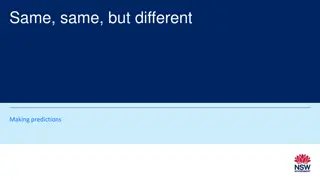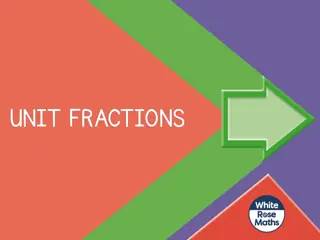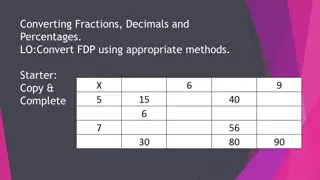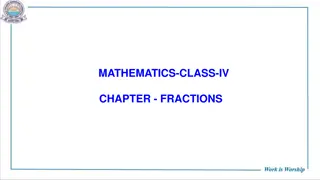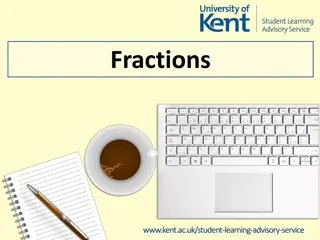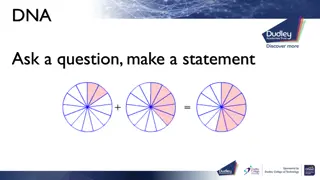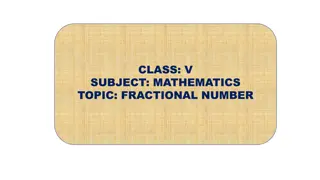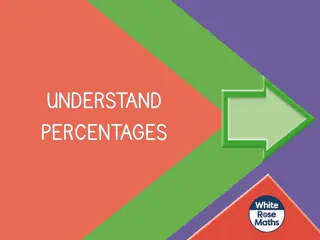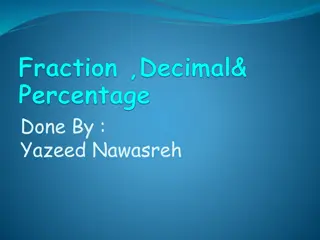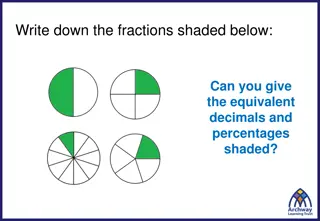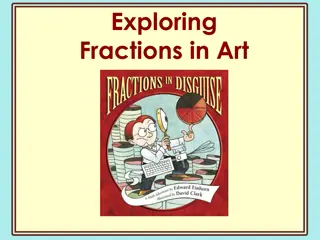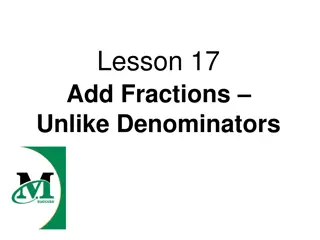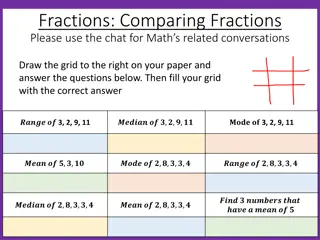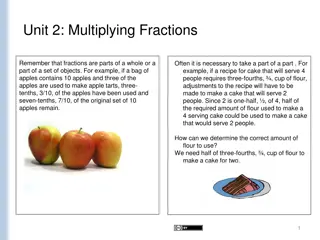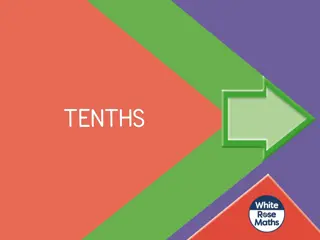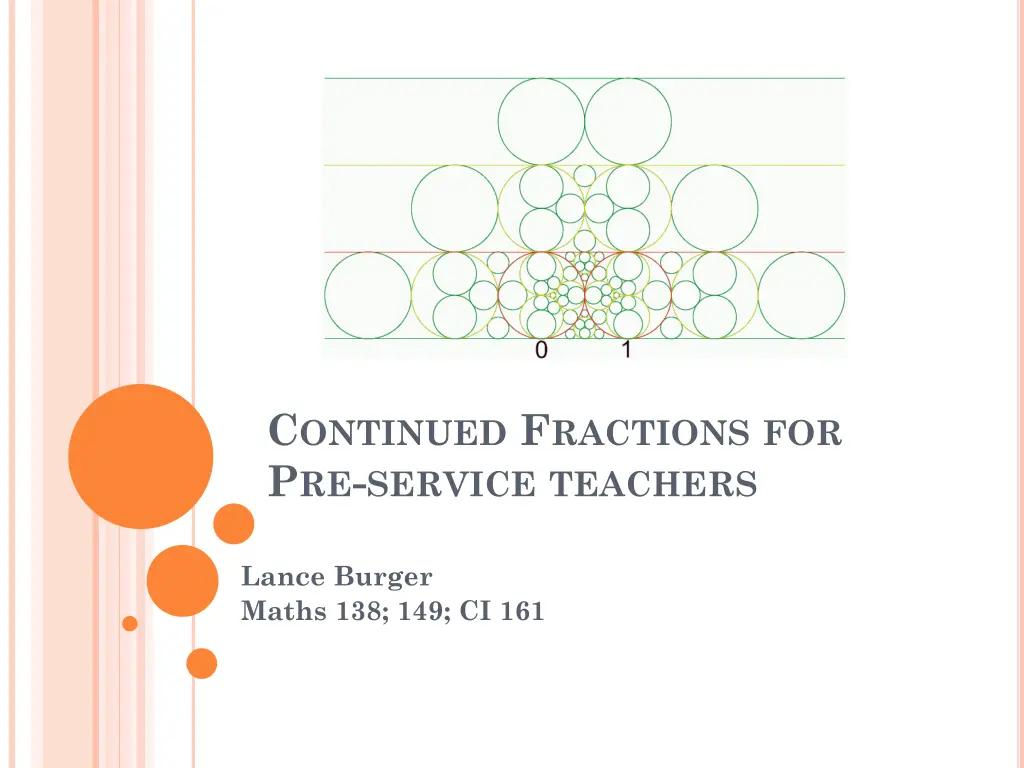
Understanding Continued Fractions in Mathematics
Discover the rich history and significance of continued fractions in mathematics, from early origins to modern theories developed by prominent mathematicians like Aryabhata, Euler, and others. Explore how continued fractions can represent numbers and their applications in solving equations. Dive into the beauty of expressing numbers as simple finite continued fractions and the profound implications for rationality.
Download Presentation

Please find below an Image/Link to download the presentation.
The content on the website is provided AS IS for your information and personal use only. It may not be sold, licensed, or shared on other websites without obtaining consent from the author. If you encounter any issues during the download, it is possible that the publisher has removed the file from their server.
You are allowed to download the files provided on this website for personal or commercial use, subject to the condition that they are used lawfully. All files are the property of their respective owners.
The content on the website is provided AS IS for your information and personal use only. It may not be sold, licensed, or shared on other websites without obtaining consent from the author.
E N D
Presentation Transcript
CONTINUED FRACTIONS FOR PRE-SERVICE TEACHERS Lance Burger Maths 138; 149; CI 161
SOME BACKGROUND Origins difficult to pinpoint. Evidence they ve been around over the last 2000 years. Typically credited to the emergence of Euclid s algorithm, as by manipulating the algorithm, one can derive the continued fraction representation for ?/?. Ex. 7 5 7 = 5 1 + 2 7 5 = 2 2 + 1 5 5= 1 +2 5 1 +1 2= 2 +1 1 2+1 2 5 2 2 7 5= 1 +1 = 1 + = [1,2,2] 5 2
SOME HISTORY The Indian mathematician Aryabhata (d. 550 AD) used a continued fraction process (to solve a linear indeterminate equation (Diophantine). He referred to the approach as Kuttaka, meaning to pulverize and break up into smaller pieces. Evidence of use of zero as well as his commentary on the irrationality of ? predates the emergence of zero (Bakhshali Manuscript) as well as Lambert s proof of the irrationality of ? (1761). [3.1416 approaching ratio of ?/?]
SOME BACKGROUND Rafael Bombelli (b. c.1530) expressed 13 as a non-terminating continued fraction. Pietro Cataldi (1548-1626) did the same for 18. John Wallis (1616-1703) developed the topic with his Arithemetica Infinitorium (1655) with results like (coined term continued fraction): 4 ?=3 3 5 5 7 7 2 4 4 6 6 12 = 1 + 32 2+ 2+52 2+
SOME BACKGROUND Not surprisingly, Euler laid down much of the modern theory in his work De Fractionlous Continious (1737) Next is an example of one of his basic theorems, but first a few preliminaries: 1 An expression of the form ?0+ is said to be a simple 1 ?1+ 1 ?2+ ?3+ continued fraction. The ??can be either real or complex numbers (the diagram on the first slide of this talk represents a complex continued fraction using circles of Apollonius)
From Eulers De Fractionlous Continious (1737): Theorem 1: A number is rational if and only if it can expressed as a simple finite continued fraction. Proof: By repeated use of the Euclidean algorithm: p = a1q + r1, 0 <= r1< q, q = a2r1+ r2, 0 <= r2< r1, r1= a3r2+ r3, 0 <= r3< r2, : : rn-3= an-1rn-2+ rn-1, 0 <= rn-1< rn-2, rn-2= anrn-1. The sequence r1, r2, r3,..., rn-1forms a strictly decreasing sequence of non-negative integers that must converge to zero in a finite number of steps.
A few examples from Eulers De Fractionlous Continious (1737) Upon rearrangement of the algorithm: ? ?= ?1+1 ? ?1 ? ?1 = ?1+1 ?1 ?2 ?? 2 ?? 1 1 = ?? 1+ ?? 1 ?? ?? 1 ?? = ??
A few examples from Eulers De Fractionlous Continious (1737) and substituting each equation into the previous yields an expression that: ? ?= ?0+ ?1+ 1 1 1 ?2+ 1 ?3+ 1 + ?? 1+1 ?? which is a finite simple continued fraction as desired. For the converse of the proof, by induction on ??: ? = 1 if a number ? = ?1then it is clearly rational since ?1 .
1 ? = ?0+ 1 ?1+ 1 ?2+ 1 ?3+ 1 + 1 ??+ ??+1 ? = ?0+1 ?, where by inductive hypothesis B is rational hence: ? = ?0+1 = ?0+? ?=?0? + ? ? ? ?
OTHER MATHEMATICAL RESULTS ABOUT CONTINUED FRACTIONS: (an investigation of this topic quickly became overwhelming!!!) Examples of continued fraction representations of irrational numbers are: 19 = [4;2,1,3,1,2,8,2,1,3,1,2,8, ]. The pattern repeats indefinitely with a period of 6. ?= [2;1,2,1,1,4,1,1,6,1,1,8, ] The pattern repeats indefinitely with a period of 3 except that 2 is added to one of the terms in each cycle. ? =[3;7,15,1,292,1,1,1,2,1,3,1, ] The terms in this representation are apparently random. Even in terms of irrational numbers pi is kind of weird! ? = 1;1,1,1,1,1,1, The Golden Mean, the most irrational of irrational numbers!
How continued fractions can form a topic ranging from the primary grades all the way to graduate level mathematics! Justifications: A mathematics Grade 3 Common Core Standard: (4) Students describe, analyze, and compare properties of two dimensional shapes. They compare and classify shapes by their sides and angles, and connect these with definitions of shapes. Students also relate their fraction work to geometry by expressing the area of part of a shape as a unit fraction of the whole.
(2) Students develop an understanding of fractions, beginning with unit fractions. Students view fractions in general as being built out of unit fractions, and they use fractions along with visual fraction models to represent parts of a whole. They solve problems that involve comparing fractions by using visual fraction models and strategies based on noticing equal numerators or denominators. The first unit in Math 100 concerns models for operations with fractions. For this talk, the focus will be on division with fractions. The Measurement model is a verbal model (Liping Ma) which threads through ALL of the other models for division discussed.
Here is an example of the measurement model: Initial problem: 3 2 2 3 Storyline using measurement model: A pizza weighs 2 pound. How many of those pizzas make 3 3 s of a 2 pounds? There are various other ways to solve this problem besides just telling students to flip and multiply!
(1) One way is to use pattern blocks. *(Demonstration on board using two hexagons as a whole.) 3 2 2 3
Proving flip and multiply is easy but intimidating to K12 students(& pre-service teachers): ? ? ? ? ? ?= ? ?? ? ? ?=?? ??=? ? ? ? ? ??? ? ??? ? 0 Why is dividing by zero meaningless? (measurement model). Ex. 3 2 3 2using pattern blocks: (*board demonstration of pattern block multiplication model with two hexagons as a whole to obtain 21 4). Three of the two halves of three halves
Fraction Division using the Area model: Based on the idea that for the area of rectangles: ? = ? ? then division can be computed by: ? ?= ? Ex. 3 2 2 3using area model (*demonstrated on board)
The continued fraction connection: Continued fractions are an interesting transition from fractional thinking to number sense, all in a context of an area model. In Math 100, students learn two definitions for rational numbers when heading into their unit on number sense: ? ? ? 0 ??? ?,? i. ii. Rational numbers are numbers with repeating decimals representations.
Area model representations of continued fractions: Ex. 45 16
Area model representations of continued fractions: Ex. 45 16 45 = 16 2 + 13 45 16= 2 +13 1 16 13 16= 2 +
Area model representations of continued fractions: Ex. 45 16 45 = 16 2 + 13 45 16= 2 +13 1 16 13 16= 2 + 16 = 13 1 + 3 16 13= 1 + 3 13
Area model representations of continued fractions: Ex. 45 16 So far: 45 1 16 13 1 1 16= 2 + = 2 + = 2 + 1+1 1+3 13 3 13 13 = 3 4 + ? 3; ?? 13 3= 4 +1 ??= ?,?,?,? , see it in the diagram?
This expression relates directly to the geometry of the rectangle-as-squares jigsaw as follows: 2 orange squares (16 x 16) 1 brown square (13 x 13) 4 red squares (3 x 3) 3 yellow squares (1 x 1) Euler s Theorem 1 geometrically: Since the (rational) numbers always reduce, that is, the size of the remaining rectangle left over will always have one side smaller than the starting rectangle, then the process will always stop with a final n-by-1 rectangle
Class exercise: Draw a continued fraction rectangle representation for: 20 11
Colloquium Exercise: Did you get an area diagram that represented 1,1,4,2 ? Reversibility: In Piaget's theory of cognitive development, the third stage is called the Concrete Operational stage. One of the important processes that develops is that of Reversibility, which refers to the ability to recognize that numbers or objects can be changed and returned to their original condition. Example of reversibility using continued fractions for developing understanding of fraction operations: Find the fraction form of you pick [ , , , , ]
The next avenue CFs can be used for it to transition from number sense to algebraic thinking, which ties in the concept of irrational numbers, as well as use of the unknown ? (VARIABLE CONCEPT) Example: 2 = [1, 2, 2, 2, 2, 2, 2, 2, 2, ... ] Extension: The Golden Ratio --- ? 1 ? ? ? = 1 ? The most irrational of all numbers!


